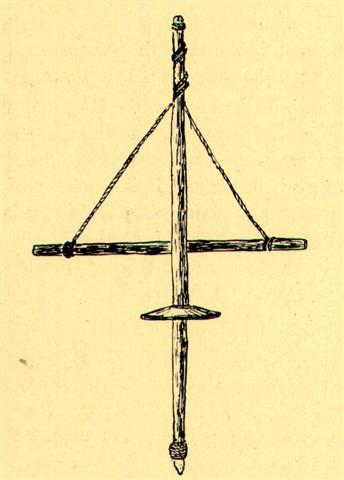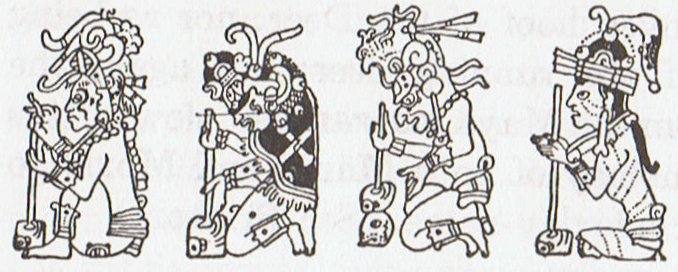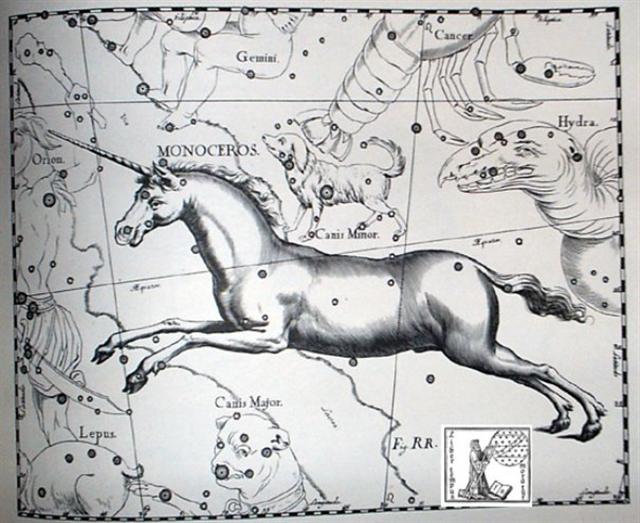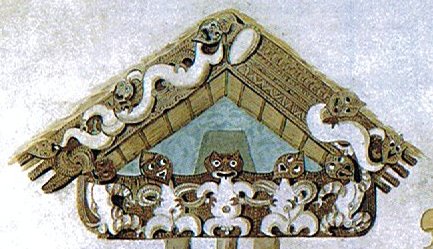Ba6.2 The idea of Bow and Arrow had to do with obtaining fire - because how else could places in the sky be reached? ... A man had a daughter who possessed a wonderful bow and arrow, with which she was able to bring down everything she wanted. But she was lazy and was constantly sleeping. At this her father was angry and said: 'Do not be always sleeping, but take thy bow and shoot at the navel of the ocean, so that we may get fire.' The navel of the ocean was a vast whirlpool in which sticks for making fire by friction were drifting about. At that time men were still without fire. Now the maiden seized her bow, shot into the navel of the ocean, and the material for fire-rubbing sprang ashore. Then the old man was glad. He kindled a large fire, and as he wanted to keep it to himself, he built a house with a door which snapped up and down like jaws and killed everybody that wanted to get in ... Therefore we should correlate the ancient star at the north pole (Vega) with that part of a net from which the weaving started (matua) - with the season of light ('fire') returning up in the sky.
Evidently spiders were able to fly by using their threads and the wind, and for them it would be no problem to move all the way up to the center of the sky (the 'navel'). Cfr Sirrah (α Andromedae) = the current Navel of the Horse at 0h. ... The left part of the central glyph (Ba4-11) in this set of 7 was explained by Metoro as a torch (rama), which could be interpreted as a reference to the star ('fire') at the north pole (Polaris). Where the central pillar turned around the friction might cause a fire ...
... They walked in crowds when they arrived at Tulan, and there was no fire. Only those with Tohil had it: this was the tribe whose god was first to generate fire. How it was generated is not clear. Their fire was already burning when Jaguar Quitze and Jaguar Night first saw it: 'Alas! Fire has not yet become ours. We'll die from the cold', they said. And then Tohil spoke: 'Do not grieve. You will have your own even when the fire you're talking about has been lost', Tohil told them. 'Aren't you a true god! Our sustenance and our support! Our god!' they said when they gave thanks for what Tohil had said. 'Very well, in truth, I am your god: so be it. I am your lord: so be it,' the penitents and sacrificers were told by Tohil. And this was the warming of the tribes. They were pleased by their fire. After that a great downpour began, which cut short the fire of the tribes. And hail fell thickly on all the tribes, and their fires were put out by the hail. Their fires didn't start up again. So then Jaguar Quitze and Jaguar Night asked for their fire again: 'Tohil, we'll be finished off by the cold', they told Tohil. 'Well, do not grive', said Tohil. Then he started a fire. He pivoted inside his sandal ... ... It should be stated right now that 'fire' is actually a great circle reaching from the North Pole of the celestial sphere to its South Pole ...
The old man's daughter was lazy and constantly sleeping, suggesting it was solstice (when the Sun hardly moved at all). Which was the same sign as that of the sleepy Dormouse. ... Dalet (dāleth, also spelled Daleth or Daled) is the fourth letter of many Semitic alphabets ... The letter is based on a glyph of the Middle Bronze Age alphabets, probably called dalt 'door' (door in Modern Hebrew is delet), ultimately based on a hieroglyph depicting a door ...
'Twinkle, twinkle, little bat!' // How I wonder what you're at!'
Anciently there were only 29 calendar days in December and therefore, we can guess, the headless figure at the Full Moon in June 29 (Ba6-2, see below) probably referred to the stars at the last day of December, before once again the old man would be able to kindle his fire. For in the next night (June 30) the Sun would reach Sirius, which however could not be seen until late at night 16 days later. ... The Sothic cycle was based on what is referred to in technical jargon as 'the periodic return of the heliacal rising of Sirius', which is the first appearance of this star after a seasonal absence, rising at dawn just ahead of the sun in the eastern portion of the sky. In the case of Sirius the interval between one such rising and the next amounts to exactly 365.25 days - a mathematically harmonious figure, uncomplicated by further decimal points, which is just twelve minutes longer than the duration of the solar year ... In ancient Egypt they thought Sirius was behind the yearly rise of the Nile ... the seasonal cycle, throughout the ancient world, was the foremost sign of rebirth following death, and in Egypt the chronometer of this cycle was the annual flooding of the Nile ... But, of course, Sirius could alternatively be positioned half a year later, viz. close to the Full Moon in December 30.
It therefore seems undeniable that the vaha mea idea was expressing the 'red dawn' (opening, door) for the year.
And, in the case of Sirius we should notice the distance 6 right ascension days as counted from June 24 when the head of a king was lost.
|
||||||||||||||||||||||||||||||||||||||||||||||||||||||||||||||||||||||||||||||||||||||||||||||||||||||||||||














